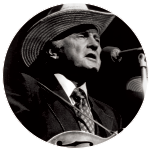Lesson 1: Learning “Uncle Pen”
Aim: What is the form of a bluegrass song?
Summary: Students learn to sing “Uncle Pen” and use movement to identify the different parts of a bluegrass song form.
Materials: Music Explorers online material and audio
Standards: GA: ESGM2.PR.1, ESGM2.RE.1, ESGM3.RE.3, ESGM2.CN.2
Vocabulary: bluegrass, break, chorus, introduction, verse
See Glossary →
Sing “Uncle Pen”
- David and Tabitha sing and play bluegrass. Bluegrass is a style of acoustic music that originated in the 1940s, incorporating traditional Appalachian music and elements of country/western, blues, and gospel. Most bluegrass bands consist of mandolin, banjo, fiddle (violin), guitar, and upright bass, and musicians trade off improvised solos, as in jazz music.
- Learn to sing the chorus of “Uncle Pen,” Track 3.
Track 3 – Uncle Pen (Chorus)

Explore form in “Uncle Pen”
- Listen to the complete song, Track 4.
Track 4 – Uncle Pen
Uncle Pen
Oh, the people would come from
far away
To dance all night ’til the break of day
When the caller hollered, “Do-Si-Do”
They knew Uncle Pen was ready to go
Chorus:
Late in the evening,
about sundown
High on the hill,
an’ above the town
Uncle Pen played the fiddle, oh,
how it’d ring
You could hear it talk,
you could hear it sing
Well, he played an old tune
he called the “Soldier’s Joy”
And he played the one
he called the “Boston Boy”
Greatest of all was the “Jenny Lynn”
To me, that’s where the fiddlin’ begins
(Chorus)
I’ll never forget that mournful day
When old Uncle Pen was called away
He hung up his fiddle and
he hung up his bow
And he knew it was time to go
(Chorus)
- There are four elements of the standard bluegrass song:
- The introduction is played just by the instruments.
- The verses tell the story.
- The chorus is repeated after each verse; it gives you the main idea of the song.
- The break is the part of the song when the instrumentalists play while the singer takes a break.
- Listen again to “Uncle Pen,” Track 4, and identify each of the four elements. Ask the students to raise their hands when they hear the chorus; they can also sing along. At the end of the song, you also can hear the fiddle tune “Jenny Lynn,” which is quoted after each chorus of “Uncle Pen.”
Move to form in “Uncle Pen”
- Ask students to stand in a circle. Students decide different movements for each of the four sections of the song (e.g., raise your hands during the introduction, walk during each verse, skip during the chorus, and do-si-do with a partner during the instrumental break).
- Ask for a student volunteer to stand in the center of the circle and be the “caller,” the person who calls out each section of the song. At the break, the students can improvise their own movements.
Creative Extension: How Bluegrass Got Its Name
- Bluegrass musicians often write songs that tell stories about people they know or something memorable that happened.
- Using SG 9, as a class, write lyrics to a song that tells a story about the day that bluegrass music got its name. Have each student contribute a line; if your students are ready, you can include the A-A-B-B rhyme scheme found in “Uncle Pen.”
- After you finish your story, share the real story of how bluegrass got its name (not nearly as interesting as your students’ story will be): Bluegrass wasn’t officially named until the 1950s; it refers to a kind of grass that grows in Appalachia called Kentucky bluegrass. The grass is not blue!
Musical Word Wall
Add bluegrass, break, chorus, introduction, and verse to the Musical Word Wall
See Glossary →
PDF Downloads
↓ SG9 How Bluegrass Got Its Name
Audio Tracks
Track 3 – Uncle Pen (Chorus)
Track 4 – Uncle Pen

